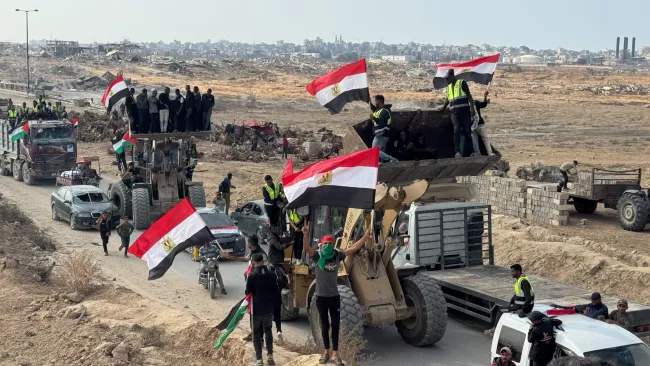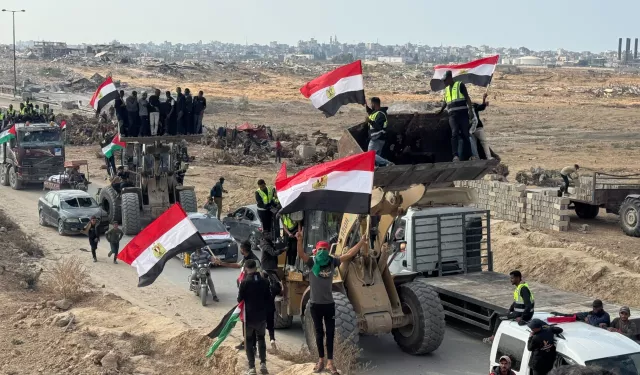The Egyptian Committee for the Reconstruction of Gaza has begun building what it says will be the largest shelter camp in the enclave, located in the Netzarim corridor—a narrow stretch of land exploited by Israeli forces to split the Gaza Strip into northern and southern zones during their ongoing military campaign.
“I am standing now on the soil of the liberated Netzarim,” said Mohamed Mansour, spokesperson for the Egyptian committee, in remarks to Al Manassa. “This area was destroyed by the Israeli army. Its residents were expelled, civilians were executed here, and it has been rendered uninhabitable.”

The Egyptian Committee for the Reconstruction of Gaza begins construction of a displacement camp in the Netzarim area, Nov. 11, 2025.The committee announced on Monday that it had constructed 16 camps across southern, central, and northern Gaza. In total, these camps are set to house approximately 100,000 displaced Palestinian families.
According to Mansour, the newly planned Netzarim camp alone will cover 2,000 dunams (2 square kilometers) and is designed to function as a self-contained city equipped with water wells, communal kitchens, bakeries, and medical clinics.
“Life will begin again in this area after it was annihilated by the Israeli army,” he said, adding “The Egyptian committee will not retreat. It will remain the right hand standing beside our people in Gaza.”
https://www.facebook.com/reel/849889970740875/
Egypt’s reconstruction efforts come as humanitarian organizations warn of growing barriers to aid delivery. UNICEF reported this week that Israel is blocking the entry of basic supplies into Gaza—including vaccination syringes and baby formula bottles—further complicating relief efforts in a war-ravaged enclave.
While UNICEF is preparing a mass immunization campaign for children, it says it faces major logistical hurdles. According to Reuters, 1.6 million syringes and solar-powered vaccine refrigerators have been stuck at customs since August, awaiting Israeli clearance.
At the same time, unnamed sources cited by Reuters suggest that Gaza may be sliding toward de facto partition, with Israel consolidating control over certain areas as US-brokered efforts to implement President Donald Trump’s postwar plan for Gaza stall.
Six European officials involved in the planning process told Reuters that the broader peace framework has effectively collapsed. They now anticipate reconstruction efforts will be limited to Israeli-controlled zones, raising the prospect of years of physical and political separation within Gaza.
Israeli control expands under Phase One
Under the first phase of Trump’s October 10 ceasefire plan, Israeli forces currently control over 53% of Gaza’s Mediterranean coastline, including large swathes of agricultural land, the city of Rafah in the south, and parts of Gaza City and other urban areas.
Meanwhile, nearly 2 million people remain crammed into makeshift camps surrounded by the rubble of destroyed neighborhoods.
The plan’s second phase—yet to be implemented—calls for a further Israeli pullback from the so-called “yellow line,” the establishment of a transitional governing authority, deployment of a multinational peacekeeping force, disarmament of Hamas, and the beginning of large-scale reconstruction.
However, no timeline or enforcement mechanisms have been established. Hamas has rejected disarmament, Israel refuses to allow any involvement by the Palestinian Authority, and the makeup and mandate of the multinational force remains unclear.
Reconstruction only under Israeli control?
According to The Wall Street Journal, both Israel and the United States are weighing a contingency plan to divide Gaza into zones separately controlled by Israel and Hamas. Under this scenario, reconstruction efforts would proceed exclusively on the Israeli-held side, serving as a stopgap measure until Hamas is disarmed and removed from governance.
Such a plan, critics argue, would entrench fragmentation, marginalize the Palestinian leadership, and risk solidifying a new political geography that could prolong the humanitarian and governance crises for years.
